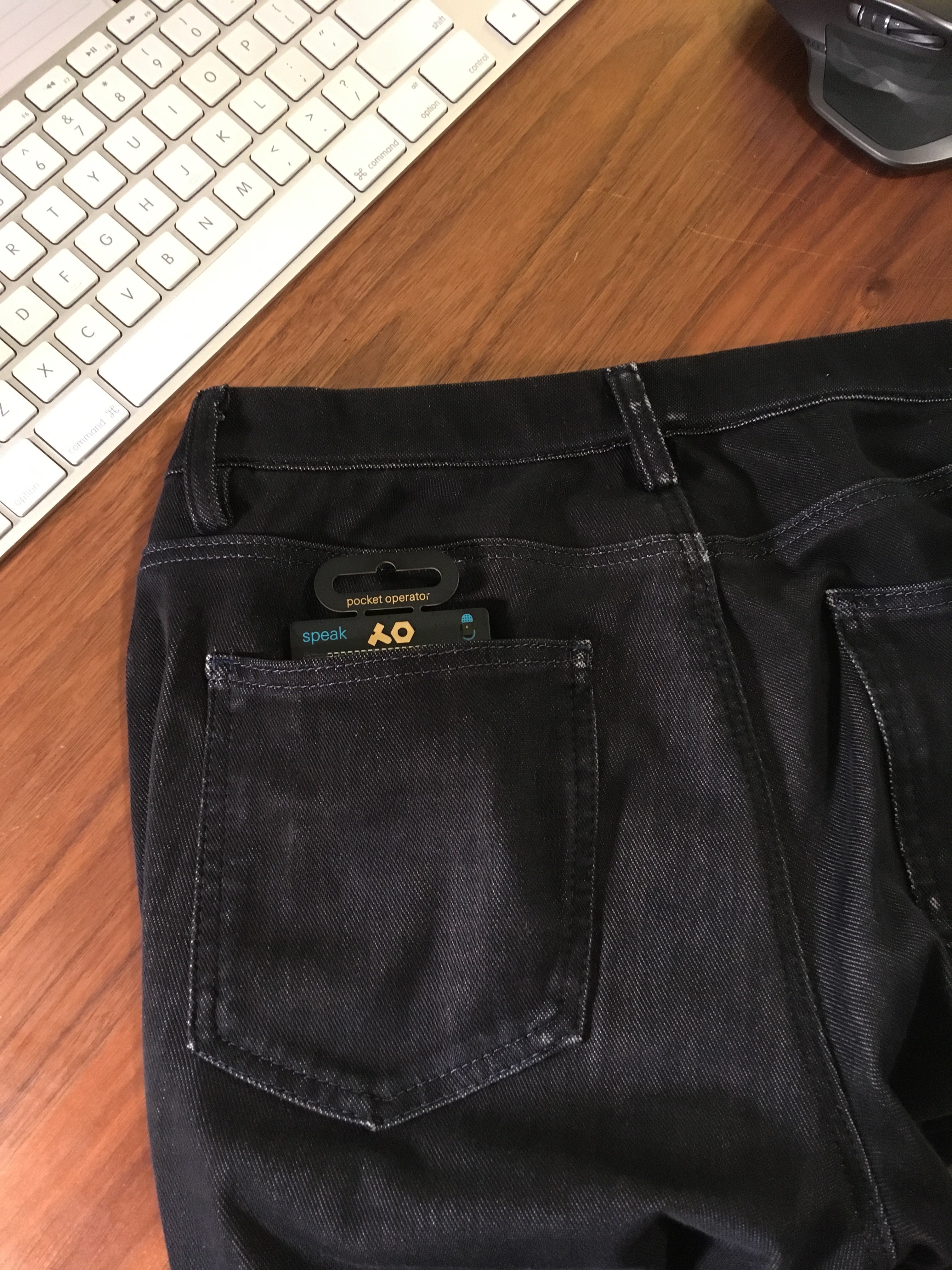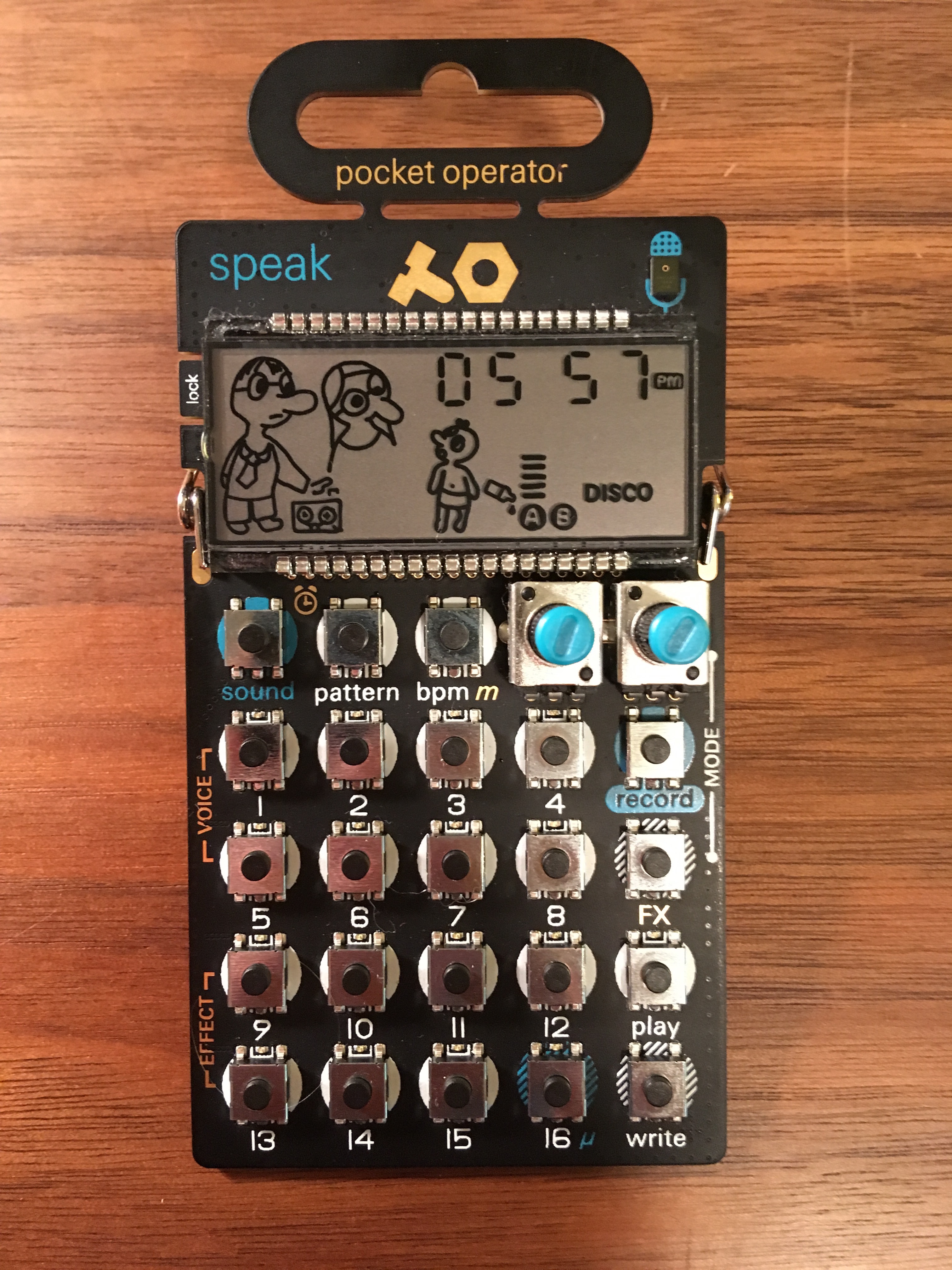Teenage Engineering Pocket Operator PO 35 Speak Review
15 Jun 2018Though I have not had this new toy for long, I decided to kick off my blog with a review of Teenage Engineering’s PO-35 Speak. Teenage Engineering added the PO-35, a vocal synthesizer designed with the method of linear predictive coding1 in mind, to their family of literally pocket-sized synthesizers this past spring.

How do you use it?
From your own voice, your favorite line from your favorite movie, or even your lawnmower starting up – you can record any sound with the PO-35 using the built-in microphone or via line-in. Instead of storing this data as a plain sample, the PO-35 manipulates and synthesizes the data in real time.

- The four rightmost buttons record samples (record), enable various effects (FX), start and stop the sequencer (play), and switch write mode on and off (write).
- The bottom-left 4 x 4 grid of buttons is employed for sequencing, playing live, and selecting from 16 recorded patterns and sounds. The 16th sound slot is reserved for a drum kit comprised of 16 different sound options.
The PO-35 has eight unique vocal options and eight different effects:
| Vocal Options | Effects |
|---|---|
| neutral | stutter sweep |
| autotune | trance gate |
| retro | half rate |
| noise | 16 bar build up |
| robot | 6/8 quantize |
| fifth | retrigger pattern |
| vocoder | reverse |
| synth | no effect |
Putting together a song
There are two ways of putting together recorded sounds and drum samples to develop patterns and later arrive at a full-fledged song: recording notes in real time and inputting notes manually via the sequencer. Once you’re satisfied with the way your patterns sound, the PO-35 has an intuitive way to chain patterns together. Simply press and hold the pattern button and select the patterns (in order) that you want to include in your chain.
Tutorials
For me, watching the following two tutorial videos was more helpful in getting up to speed on the device’s controls than reading through the instruction manual on Teenage Engineering’s website:
Pros
- Portability: as the picture above demonstrates, the PO-35 Speak truly is pocket-sized. I adore that I can work on patterns on the bus while commuting to work or sitting in the sun at the nearby park. It is a great feeling to be able to work on music projects without being glued to my PC at home.
- I can’t quite put my finger on what it is yet, but there is something I enjoy about having a physical instrument in my hands to work with as opposed to navigating around an app.
- Price: coming in at $89, the PO-35 is perhaps one of the most accessible options out there for a portable vocal synthesizer.
- Sharing: The PO-35 provides a simple way to back up data to an external device to put back on your pocket operator at a later time or even send to someone else with a pocket operator to tinker around with.
Cons
- Because the PO-35 has a bare-bones circuit board design, I have to be extra careful not to get too excited while writing and spill my morning coffee all over it. Luckily, this danger is not unavoidable. Teenage Engineering does sell cases for its line of pocket operators.
- The PO-35 takes two AAA batteries. Though the instrument is incredibly portable, I would not enjoy having the batteries suddenly die on me shortly after getting into a groove working on a new track. I guess having backup batteries on hand can’t hurt?
- Compositions on the PO-35 are limited to two tracks. However, many may actually see this constraint as a benefit since it encourages the writer to think about music in new and interesting ways.
Going Forward
While I hope this post serves as a place to start for those curious about the PO-35, this review is not a comprehensive overview of all the PO-35 Speak’s capabilities (details about additional sound and pattern modifications such as tempo, pitch, sample start, and scale, for example, can be found in the tutorial videos mentioned above).
Thus far, I’ve mainly been playing around with growing comfortable with the PO-35’s controls by experimenting with short and fast-paced patterns, but I would like to write more lush and slow-moving ambient pieces with this new instrument. This is going to take more dedicated time and patience on my part. :) While I continue experimenting, I am excited to see and hear what projects other people are up to with their pocket operators.
The following videos are my favorite demonstrations of the power of the pocket operator I have encountered so far:
1: The PO-35 Speak was designed around the concept of linear predictive coding. Paul Lansky’s 1994 composition “notjustmoreidlechatter” was created using this method. Paul Lansky is a pioneer in the world of computer music, and this seminal piece, composed of scraps of recorded speech meshed together to form a rich and swirling progression of just barely unintelligible voices, is one of my favorite electronic compositions and served as inspiration for this blog!
comments powered by Disqus